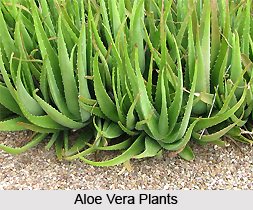 Aloe Babadensis Mill was introduced to India from the American tropics and grown in gardens. The plants are largely used almost throughout the country for its commercial medicinal products. Apart from being a medicinal plant, Aloe Babadensis Mill or Indian Aloe is used in many beauty products. Applying these on the face brings a fresh look and improves the skin type. The plant is now naturalized in many parts of the country near where it has been planted.
Aloe Babadensis Mill was introduced to India from the American tropics and grown in gardens. The plants are largely used almost throughout the country for its commercial medicinal products. Apart from being a medicinal plant, Aloe Babadensis Mill or Indian Aloe is used in many beauty products. Applying these on the face brings a fresh look and improves the skin type. The plant is now naturalized in many parts of the country near where it has been planted.
The leaves of Aloe Babadensis Mill are sessile, erect, and crowded in a basal rosette, succulent and glaucous-green. They are 30-60 cm long, narrowly lanceolate, apex long acuminate, smooth except for the spiny teeth on the margins. The flowers are reddish-yellow, borne in dense racemes at the end of a tall, scaly, branched stalk (scape) longer than the leaves; bracts short lanceolate, longer than the pedicel.
The fresh juice obtained from the cut bases of the Aloe leaves is cathartic and cooling. The juice is often used to treat eye diseases, liver and spleen ailments, muscular pain, dermatitis, burns, cutaneous leishmaniasis and other skin problems. To relieve burns, insect and fish bites, skin ailments, arthritis, myopathies, Aloe babadensis mill is used as external application. The plant is also used for manufacturing beauty products as hair conditioners and skin creams. The rural inhabitants of Gujarat use the pulp of the leaf to cure piles, boils, burns and swellings. It is considered effective to reduce excessive body fats.
The dried juice of Aloe Babadensis Mill is an efficacious ingredient of a large number of Ayurvedic preparations, especially for the treatment of diseases that are associated with the digestive system. Apart from being of large use in Ayurveda and cosmetics the plant plays an important role in treating menstrual diseases, stomach pain, or relieving constipation and as a tonic after pregnancy. The root of the plant is also in huge demand for its utilization in the treatment of acute abdominal pain. In Gujarat the leaves and flowers are eaten after pickling. Not only as an ayurvedic ingredient, the leaves of Aloe yield a useful fibre, and a dye is prepared from the plant. The dye made out of the plant imparts a purple colour to silk, black to wool and pink to linen.
Aloe Babadensis Mill is popular as `ghritakumari` in West Bengal. In Gujarati it is called in many names such as dadv-inahani, kadvikunvar, kumarpathu, kunvar, kunwarpathu. The inhabitants of Kannada specify the plant as kolasoare, komarika, lolisara and maulisara and are popular as elwa in Punjab.



















